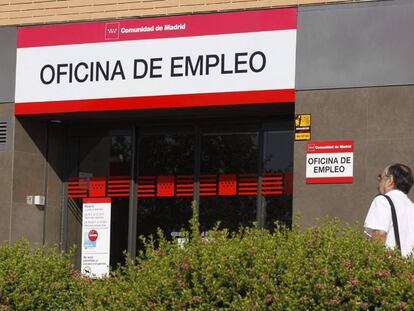Jobless rate in Spain falls below 20% for first time in six years
Three-month summer period saw creation of 226,500 new jobs, mainly in tourism

Spain’s official unemployment rate has fallen below 20% for the first time in six years. Figures from the National Statistics Institute (INE) for the third quarter put joblessness at 18.91%, bringing to an end the longest period in the last 40 years when more than one in five of the working population was idle.
The fall in unemployment is due both to job creation as well as fewer people being laid off. Summer traditionally sees an increase in employment, with the tourist industry taking on large numbers of temporary workers. This year has been exceptionally healthy for the tourism sector, creating some 226,500 jobs in three months, putting the total number of people in work at some 18,520,000. The sectors most involved are hospitality, health and retail, which has been reflected in the numbers of men and women contributing to the Social Security scheme.
Unemployment above 20% is not uncommon in Spain
Reducing Spain’s unemployment levels has proved difficult. The high water mark was the first quarter of 2013, when the rate hit 26.94%, with some 6,278,000 out of work. The INE’s latest figures put the number of people without a job during the third quarter of this year at 4,320,000.
During this period, some 27,300 people were laid off from their jobs.
The private sector has driven employment, creating 217,700 jobs, with the public sector contributing just 8,900 posts.
The start of the school year has also provided new employment opportunities in education, as well as administrative activities and manufacturing.
The INE’s data suggests that temporary and seasonal work, a hallmark of the Spanish job market, is growing even in sectors that were not as prone to it in the past. This is the case with education and manufacturing, where non-permanent jobs have been rising in recent years.
Spain’s unemployment is so high partly because of particular local forces that have existed for decades. Unemployment above 20% is not uncommon in Spain. In fact, it has been at that level in three periods since Spain’s transition to democracy in the 1970s. And, ominously, from the previous unemployment rate peak in the 1990s, it took 14 years for it to decline to the wider European level.
English version by Nick Lyne.
Tu suscripción se está usando en otro dispositivo
¿Quieres añadir otro usuario a tu suscripción?
Si continúas leyendo en este dispositivo, no se podrá leer en el otro.
FlechaTu suscripción se está usando en otro dispositivo y solo puedes acceder a EL PAÍS desde un dispositivo a la vez.
Si quieres compartir tu cuenta, cambia tu suscripción a la modalidad Premium, así podrás añadir otro usuario. Cada uno accederá con su propia cuenta de email, lo que os permitirá personalizar vuestra experiencia en EL PAÍS.
¿Tienes una suscripción de empresa? Accede aquí para contratar más cuentas.
En el caso de no saber quién está usando tu cuenta, te recomendamos cambiar tu contraseña aquí.
Si decides continuar compartiendo tu cuenta, este mensaje se mostrará en tu dispositivo y en el de la otra persona que está usando tu cuenta de forma indefinida, afectando a tu experiencia de lectura. Puedes consultar aquí los términos y condiciones de la suscripción digital.
More information
Archived In
Últimas noticias
Pinochet’s victims grapple with José Antonio Kast’s rise in Chile
Reinhard Genzel, Nobel laureate in physics: ‘One-minute videos will never give you the truth’
How Japan is trying to avert ‘digital defeat’
The complicated life of Francesca Albanese: A rising figure in Italy but barred from every bank by Trump’s sanctions
Most viewed
- Pablo Escobar’s hippos: A serious environmental problem, 40 years on
- Why we lost the habit of sleeping in two segments and how that changed our sense of time
- Charles Dubouloz, mountaineering star, retires at 36 with a farewell tour inspired by Walter Bonatti
- Trump’s obsession with putting his name on everything is unprecedented in the United States
- The Florida Keys tourist paradise is besieged by immigration agents: ‘We’ve never seen anything like this’










































